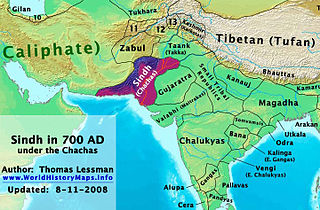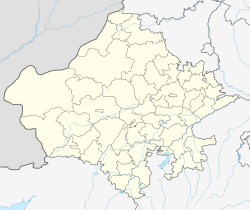
The Pratihara dynasty, also called the Gurjara-Pratiharas, the Pratiharas of Kannauj or the Imperial Pratiharas, was a prominent medieval Indian dynasty which ruled over the Kingdom of Kannauj. It initially ruled the Gurjaradesa until its victory in the Tripartite Struggle in 816 which secured its right to the throne of Kannauj. Cadet branches of the dynasty ruled other minor states in the subcontinent.

Osian is an ancient town located in the Jodhpur District of Rajasthan state in western India. It is an oasis in the Thar Desert. The town is a panchayat village and the headquarters for Osian tehsil. It lies 69 km (43 mi) by road north of the district headquarters at Jodhpur, on a diversion off the main Jodhpur – Bikaner Highway. The under-construction Amritsar Jamnagar Expressway passes through this town.
Jalore, also known as Granite City, is a city in the western Indian state of Rajasthan. It is the administrative headquarters of Jalore District.

Bappa Rawal was a king of the Mewar kingdom in Rajasthan, India. The chronicles consider him to be the founder of the Guhila Rajput dynasty. He is credited with repelling the Arab invasion of India. He is identified as the ruler of the Guhila dynasty, and called by the names Kalabhoja, Shiladitya, and Khumana.
Nagabhata I was the founder of the imperial Pratihara dynasty in northern India. He ruled the Avanti region in present-day Madhya Pradesh, from his capital at Ujjain. He may have extended his control over Gurjaradesa, which includes parts of present-day Gujarat and Rajasthan. He repulsed an Arab invasion from Sindh, probably led by Junayd ibn Abd al-Rahman al-Murri or Al Hakam ibn Awana.

Jalore District is a district of Rajasthan state in western India. The city of Jalore is the administrative headquarters of the district. The district has an area of 10,640 km2 (4,108 sq mi), and a population of 1,828,730, with a population density of 136 persons per square kilometre.
The Oswal are a Śvetāmbara Jain-majority Baniya community with origins in Osian, a town in the Marwar region of Rajasthan, India. They claim to be of Rajput descent. The Osavālas origin legend has multiple aspects, all of which include a fierce, meat-eating goddess who becomes pacified by a Jain ascetic, involving the conversion of a king to Jainism. In modern times, there are barely any Osavālas living in Osiyān, but they still regard the Mahavira temple and Sachiya Mata Temple as their "mother temples". They reside in Rajasthan, Malwa, Gujarat, and Kutch.
Shrimali Brahmins are believed to have originated from Srimal in Jalore district in the Indian state of Rajasthan. They also have a presence in Gujarat. The Śrīmāḷī Brāhmāṇs consider themselves to be the descendants of rishis who came to Śrīmāla, the city that Viśvakarma built for Lakṣmī.
Jaswantpura is a tehsil in the Jalore district of Rajasthan, India. It is the headquarters of Panchayat Samiti (block) and a part of the Jaswantpura subdivision; before 1947, it was the headquarters of the Pargana. The village was declared a tehsil in the Rajasthan budget 2012–13, and is named after the ruler of Marwar, Jodhpur: Maharaja Jaswant Singh

Sundha Mata temple is a nearly 900-year-old temple of Mother goddess Chamunda situated on a hilltop called Sundha, located at longitude 72.367°E and latitude 24.833°N, in Jalore District of Rajasthan, India. It is 64 km (40 mi) from Mount Abu and 20 km (12 mi) from the town of Bhinmal.

The Umayyad Dynasty came to rule the Caliphate in 661 CE, and during the first half of the 8th century CE, a series of battles took place in the Indian subcontinent between armies of the Umayyad Caliphate and Indian kingdoms situated to the east of the Indus river, subsequent to the Arab conquest of Sindh during 711 – 713 CE.

Poravāla, correctly called Poravāḍa, is a Bania community that originated in southern Rajasthan, India. They are mainly of Jain or Hindu faith. The name Poravāla was applied on the basis of the names of other Bania communities.

The history of human settlement in the western Indian state of Rajasthan dates back to about 100,000 years ago. Around 5000 to 2000 BCE many regions of Rajasthan belonged as the site of the Indus Valley Civilization. Kalibangan is the main Indus site of Rajasthan, here fire altars have been discovered, similar to those found at Lothal.

The Tripartite Struggle (785–816), also called the Kannauj Triangle Wars, were a series of wars in northern India fought over the control of the throne of Kannauj, which during that time was equivalent to having imperial status over all of Aryavarta. It involved the three powerful rulers of the era – the King of the Gurjaras, the King of Gauda (Bengal) and the King of the South. The war ultimately resulted in Nagabhata II, King of the Gurjaras, winning the crown of Kannauj in 816, and proclaiming himself King of Kannauj.

The Chaulukya dynasty, also Solanki dynasty, was a dynasty that ruled the Kingdom of Gujarat in western India, between c. 940 CE and c. 1244 CE. Their capital was located at Anahilavada. At times, their rule extended to the Malwa region in present-day Madhya Pradesh. The family is also known as the "Solanki dynasty" in the vernacular literature. They belonged to the Solanki clan of Rajputs.
Gurjaradesa, is a historical region in India comprising the southern Rajasthan and northern Gujarat during the period of 6th–12th century CE. The predominant power of the region, the Gurjara-Pratiharas eventually controlled a major part of North India centered at Kannauj. The modern state of "Gujarat" derives its name from the ancient Gurjaratra.
The origin of the Gurjara-Pratihara dynasty of India is a topic of debate among historians. The rulers of this dynasty used the self-designation "Pratihara" for their clan, but have been described as "Gurjara" by some of their neighbouring kingdoms. Only one particular inscription of a feudatory ruler named Mathanadeva mentions him as a "Gurjara-Pratihara".
Kshemkari Mata temple is an old temple of Mother Goddess Kshemkari, also known as Khimaj Mata situated on a mountain, located at Latitude 24.998°N and Longitude 72.239°E, in Bhinmal, Jalore District of Rajasthan. It is 25 km from Sundha Mata Temple. Khimaj Mata was a Kuldevi of Solanki Rajput.
Swayamprabhasuri or Svayamprabhasuri was a Śvetāmbara Jain ascetic and the 5th successor in the lineage of the monastic heads of the Chaturvidha Sangha's Upkeśa Gaccha. He succeeded Keśiśramanācharya and is believed to have existed in 6th–5th century BC. He is known for establishing the Śrīmali and Porvāl clans.
Ratnaprabhasuri was a Śvetāmbara Jain ascetic and the 6th successor in the lineage of the monastic heads of the Chaturvidha Sangha's Upkeśa Gaccha. He succeeded Swayamprabhasuri and is believed to have existed in 6th–5th century BC. He is most well-known as the founder of the Oswāl clan of Śvetāmbara Jains.














